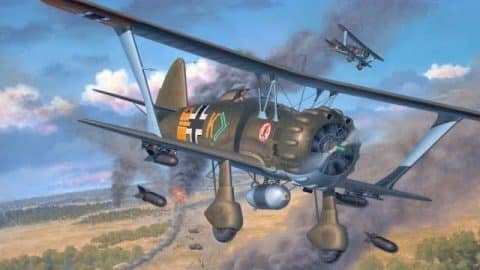Germany’s Other ‘Stuka’ – The Eastern Front Menace

YouTube / Mark Felton Productions
The Germans had a spectacularly successful biplane that is virtually unknown today. They called it the Henschel Hs. 123 – or the OTHER Stuka.
The Hs. 123
The plane entered service in 1936 as a single-seat dive bomber. All metal, clean lines, and extremely maneuverable, the Hs. 123 had lower wings that were significantly smaller than the upper wings.

Unlike traditional biplanes, it was brought into service to give a stopgap between the older Heinkel He 50 biplane dive bomber and the new Junkers Ju 87 Stuka.
Luftwaffe Version
The standard Luftwaffe version of the Hs. 123 carried four SC50 50-kg bombs in the lower wing racks, and an SC250 250-kg bomb on a center rack. It was also armed with two Mg17 7.92 mm machine guns firing through the propeller.

The Hs. 123 first flew in combat flying with the German Condor legion during the Spanish Civil War in 1936 to 1939, proving itself to be an excellent ground aircraft that can bomb accurately and take significant punishment from ground fire.
Outbreak of WWII
However, when WWII rolled in, the Luftwaffe wanted to get rid of the Hs. 123 as it was outdated. The remaining 39 Hs. 123s did go to war with Poland where it performed quite well.
Stuka Comparison
Just like the famous Stuka howl, the Hs. 123 can also make a terrifying noise in battle where the pilot can change the RPM on the plane’s engine, producing a gunfire-like noise that terrified enemy troops.

It was also considered a lot more rugged than the Stuka and could take damage while remaining airworthy. It proved to be an excellent dive bomber and general ground attack plane.
In fact, during the Luftwaffe’s French and Belgian campaigns, these planes flew more missions per day than Junkers Ju 87 squadrons could match. However, they became easy prey in the Battle of Britain for RAF Spitfires and Hurricanes.
Retirement
The Hs. 123s continued to prove its worth to the Germans – some of the battles it fought were a campaign in Greece in 1941 and Operation Barbarossa – the German invasion of the Soviet Union.

The last dozen of Hs. 123s soldiered on, fighting Kirsk and Crimea until late spring 1944 when the squadron finally retired the type and transferred on to the Stuka. Today, no examples of this exceptional aircraft remain.




















